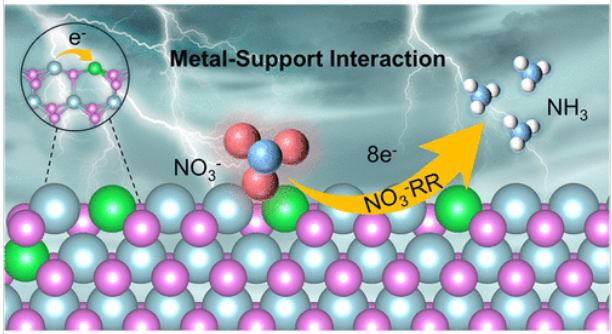
近日,复旦大学刘洋团队研究了Ni-WS2催化剂中金属-载体相互作用加速硝酸电还原制氨。2025年7月22日出版的《美国化学会志》发表了这项成果。
电催化硝酸还原反应(NO3-RR)是处理含NO3废水和实现可持续氨(NH3)合成的一条很有前途的途径。虽然二维(2D)过渡金属二硫族化合物(TMDs)催化剂作为各种电催化反应的催化剂已被广泛研究,但其在NO3-RR中的实际应用仍然受到固有的缓慢动力学和不够稳定性的阻碍。金属支撑相互作用(MSI)增强了电荷转移并稳定了催化位点,为解决这些挑战提供了一个令人信服的策略。
研究组通过两步策略设计了一种MSI驱动的Ni-WS2催化剂。Ni-WS2催化剂表现出优异的NO3-RR性能,在- 0.3 VRHE下法拉第效率为91.7%,在- 0.7 VRHE下NH3产率为23.3 mg h-1 cm-2。值得注意的是,Ni-WS2催化剂在膜电极组件(MEA)中保持了优异的稳定性,在100小时内维持了≈32 mg h- 1 cm-2的NH3产量,超过了之前报道的大多数基于TMD的催化剂。密度泛函理论(DFT)计算表明,Ni金属与WS2载体之间的MSI诱导了界面电荷重分布,优化了关键中间体的吸附能,降低了速率决定步骤(*NH2→*NH3)的能垒。此外,用Ni-WS2阴极组装的Zn-NO3-电池表现出优异的性能。该研究提出了一种通过定向MSI调制两步法合成高性能NO3-RR电催化剂的策略。
附:英文原文
Title: Accelerating Nitrate Electroreduction to Ammonia via Metal–Support Interactions in Ni-WS2 Catalysts
Author: Jiangnan Lv, Qianwen Yang, Tingting Liang, Xiaoting Sun, Wanting Rong, Qiqi Dai, Yizhi Gao, Lanfang Wang, Xiaohong Xu, Yang Liu
Issue&Volume: July 22, 2025
Abstract: Electrocatalytic nitrate reduction reaction (NO3–RR) is a promising route for both treating NO3–-containing wastewater and enabling sustainable ammonia (NH3) synthesis. While two-dimensional (2D) transition metal dichalcogenides (TMDs) catalysts have been widely investigated as catalysts in various electrocatalytic reactions, their practical application in NO3–RR remains hindered by inherently sluggish kinetics and insufficient stability. Metal–support interaction (MSI), which enhances charge transfer and stabilizes catalytic sites, offers a compelling strategy to address these challenges. Herein, we design an MSI-driven Ni-WS2 catalyst via a two-step strategy. The Ni-WS2 catalyst demonstrates outstanding NO3–RR performance, achieving a Faradaic efficiency of 91.7% at 0.3 VRHE with an NH3 yield rate of 23.3 mg h–1 cm–2 at 0.7 VRHE. Significantly, the Ni-WS2 catalyst maintained an exceptional stability in a membrane electrode assembly (MEA), sustaining ≈32 mg h–1 cm–2 NH3 production over 100 h, surpassing most previously reported TMD-based catalysts. Density functional theory (DFT) calculations reveal that MSI between Ni metal and WS2 support induces interfacial charge redistribution, optimizes adsorption energy of key intermediates and lowers the energy barrier for the rate-determining step (*NH2 → *NH3). Furthermore, the Zn-NO3– battery assembled with Ni-WS2 cathode exhibits remarkable performance. This work advances a two-step synthesis strategy for high-performance NO3–RR electrocatalysts through targeted MSI modulation.
DOI: 10.1021/jacs.5c06333
Source: https://pubs.acs.org/doi/abs/10.1021/jacs.5c06333
JACS:《美国化学会志》,创刊于1879年。隶属于美国化学会,最新IF:16.383
官方网址:https://pubs.acs.org/journal/jacsat
投稿链接:https://acsparagonplus.acs.org/psweb/loginForm?code=1000
